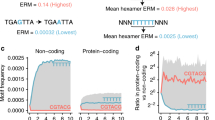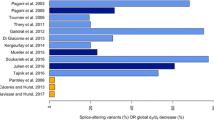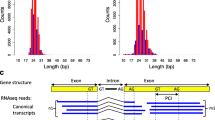Abstract
The human SNP database was used to detect selection on 238 hexamers previously identified as exonic splicing enhancers (ESEs). We compared the distribution of the 238 putative ESEs in biallelic and triallelic SNPs within five different functional categories of the SNP database: synonymous, nonsynonymous, introns, UTRs, and nongenic SNPs. Since true ESEs do not function outside of exons, SNPs that disrupt ESE motifs were expected to be more common in nonexonic portions of the genome. Our results supported this expectation: ESEs were least prevalent within synonymous SNPs and most common in nongenic SNPs. There were ∼11% fewer ESEs within synonymous biallelic SNPs than expected under no selective constraint. We also compared the frequency of neutral SNPs, those where neither allele was an ESE, with deleterious SNPs, those where one or more alleles was an ESE, across the five different functional classes of SNPs. In comparison with the other functional classes of SNPs, synonymous SNPs contained an excess of neutral variants (+1.64% and +6.04% for biallelic and triallelic SNPs, respectively) and a dearth of deleterious variants (−13.11% and −52.39% for biallelic and triallelic SNPs, respectively). The observed patterns were consistent with purifying selection on the 238 hexamers to maintain their function as ESEs. However, in contrast to previous work, we did not find evidence for selection to maintain ESE function at nonsynonymous SNPs because selection at the protein level probably obscured any difference at the level of ESE function.
Similar content being viewed by others
References
Ast G (2004) How did alternative splicing evolve? Nat Rev Genet 5:773–782
Berget SM (1995) Exon recognition in vertebrate splicing. J Biol Chem 270:2411–2414
Blencowe BJ (2000) Exonic splicing enhancers: mechanism of action, diversity and role in human genetic diseases. Trends Biochem Sci 25:106–110
Carlo T, Sierra R, Berget SM (2000) A 5′ splice site-proximal enhancer binds SF1 and activates exon bridging of a microexon. Mol Cell Biol 20:3988–3995
Cartegni L, Chew SL, Krainer AR (2002) Listening to silence and understanding nonsense: exonic mutations that affect splicing. Nat Rev Genet 3:285–298
Cartegni L, Wang J, Zhu Z, Zhang MQ, Krainer AR (2003) ESEfinder: a web resource to identify exonic splicing enhancers. Nucleic Acids Res 31:3568–3571
Charlesworth B, Morgan MT, Charlesworth D (1993) The effect of deleterious mutations on neutral molecular variation. Genetics 134:1289–1303
Cooper TA, Mattox W (1997) The regulation of splice-site selection, and its role in human disease. Am J Hum Genet 61:259–266
Fackenthal JD, Cartegni L, Krainer AR, Olopade O (2002) BRCA2 T2722R is a deleterious allele that causes exon skipping. Am J Hum Genet 71:625–631
Fairbrother WG, Yeh RF, Sharp PA, Burge CB (2002) Predictive identification of exonic splicing enhancers in human genes. Science 297:1007–1013
Fairbrother WG, Holste D, Burge CB, Sharp PA (2004) Single nucleotide polymorphism-based validation of exonic splicing enhancers. PLoS Biol 2:1388–1395
Fay JC, Wu C (2003) Sequence divergence, functional constraint, and selection in protein evolution. Annu Rev Genomics Hum Genet 4:213–235
Fay JC, Wyckoff GJ, Wu C (2001) Positive and negative selection in the human genome. Genetics 158:1227–1234
Graveley BR (2000) Sorting out the complexity of SR protein functions. RNA 6:1197–1211
Graveley BR (2001) Alternative splicing: increasing diversity in the proteomic world. Trends Genet 17:100–107
Harrison PM, Kumar A, Lang N, Snyder M, Gerstein M (2002) A question of size: the eukaryotic proteome and the problems in defining it. Nucleic Acids Res 30:1083–1090
International Human Genome Sequencing Consortium (2004) Finishing the euchromatic sequence of the human genome. Nature 431:931–945
Li W-H (1997) Molecular evolution. Sinauer Associates, Sunderland, MA
Liu H-X, Zhang M, Krainer AR (1998) Identification of functional exonic splicing enhancer motifs recognized by individual SR proteins. Genes Dev 12:1998–2012
Majewski J, Ott J (2002) Distribution and characterization of regulatory elements in the human genome. Genome Res 12:1827–1836
Maniatis T, Tasic B (2002) Alternative pre-mRNA splicing and proteome expansion in metazoans. Nature 418:236–243
Moseley CT (2002) An exon splice enhancer mutation causes autosomal dominant GH deficiency. J Clin Endocrinol Metab 87:847–852
Ng PC, Henikoff S (2001) Predicting deleterious amino acid substitutions. Genome Res 11:863–874
Pfarr N, Prawitt D, Kirschfink M, Schroff C, Knuf M, Habermehl P, Mannhardt W, Zepp F, Fairbrother W, Loos M, Burge CB, Pohlenz J (2005) Linking C5 deficiency to an exonic splicing enhancer mutation. J Immunol 174:4172–4177
Phillips DL, Park JW, Graveley BR (2004) A computational and experimental approach toward a priori identification of alternatively spliced exons. RNA 10:1838–1844
Rappsilber J, Ryder U, Lamond A, Mann M (2002) Large-scale proteomic analysis of the human spliceosome. Genome Res 12:1231–1245
Shiga N (1997) Disruption of the splicing enhancer sequence within exon 27 of the dystrophin gene by a nonsense mutation induces partial skipping of the exon and is responsible for Becker muscular dystrophy. J Clin Invest 100:2204–2210
Sokal RR, Rohlf FJ (1995) Biometry: the principles and practice of statistics in biological research. WH Freeman, New York
Sorek R, Ast G (2003) Intronic sequences flanking alternatively spliced exons are conserved between human and mouse. Genome Res 13:1631–1637
Staley JP, Guthrie C (1998) Mechanical devices of the spliceosome: motors, clocks, springs, and things. Cell 92:315–326
Steiner B, Truninger K, Sanz J, Schaller A, Gallati S (2004) The role of common single-nucleotide polymorphisms on exon 9 and exon 12 skipping in nonmutated CFTR alleles. Hum Mutat 24:120–129
Sterner DA, Berget SM (1993) In vivo recognition of a vertebrate mini-exon as an exon-intron-exon unit. Mol Cell Biol 13:2677–2687
Sun H, Chasin LA (2000) Multiple splicing defects in an intronic false exon. Mol Cell Biol 20:6414–6425
Sunyaev S, Ramensky V, Bork P (2000) Towards a structural basis of human non-synonymous single nucleotide polymorphisms. Trends Genet 16:198–200
Yeo G, Hoon S, Venkatesh B, Burge CB (2004) Variation in sequence and organization of splicing regulatory elements in vertebrate genes. Proc Natl Acad Sci USA 101:15700–15705
Zhang XH-F, Heller K, Hefter I, Leslie CS, Chasin LA (2003) Sequence information for the splicing of human pre-mRNA identified by support vector machine classification. Genome Res 13:2637–2650
Acknowledgment
This research was supported in part by NSF Grant 0315468 awarded to D.B.C.
Author information
Authors and Affiliations
Corresponding author
Rights and permissions
About this article
Cite this article
Carlini, D.B., Genut, J.E. Synonymous SNPs Provide Evidence for Selective Constraint on Human Exonic Splicing Enhancers. J Mol Evol 62, 89–98 (2006). https://doi.org/10.1007/s00239-005-0055-x
Received:
Accepted:
Published:
Issue Date:
DOI: https://doi.org/10.1007/s00239-005-0055-x




